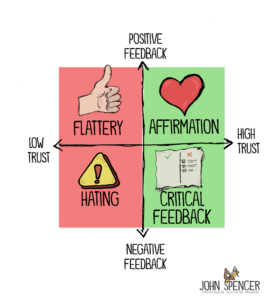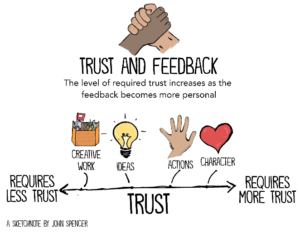I’ve worked with many organizations and groups over the years to determine and resolve challenges…

Can Feedback be Successful in Conflict Situations?
Creating a culture of feedback is a phrase I hear more and more in workplaces. This is because each of us needs feedback in order to grow and employee growth is essential for effective organizational growth. Organizations may be spending a large amount of their budget on leadership training to ensure leaders are learning skills and tools to provide feedback effectively. I’ve noticed that even when these tools are used appropriately, feedback does not always land successfully and defensiveness rears it’s head, especially in conflict situations. When defensiveness is present, growth is not. This is most likely because trust plays an important role in feedback.
I have witnessed strong defensiveness when feedback is provided in situations when trust is low, say for example between a leader and employee in conflict. As a neutral third party, I’m sometimes viewed as a more trusted person especially if an employee is in conflict with their leader. I could repeat the same feedback word for word and it was well accepted coming from me, with little defensiveness created. This can be frustrating for the feedback provider and upon further exploration the recipient will often acknowledge that they are unaware of the dynamic. In general, the success of giving feedback has little to do with the ability of the speaker and more to do with the level of trust or quality of the working relationship. When employees and their leaders are in conflict the working relationship may be damaged and trust is likely low.
 I’ve shared this pictorial grid created by John Spencer, an educator who looked at student peer feedback and levels of trust. He found that when there is low trust, negative feedback could be seen as hating, creating a very defensive reaction. Mutual, or high trust is vital for critical or meaningful feedback. Employee’s defenses will be less pronounced if someone they trust is involved and they are able to hear the feedback that will help them change and grow. If trust is low, positive feedback may not been seen as authentic and viewed as flattery or insincere. With those whom employees place high trust in, positive feedback can create a true sense of affirmation. How many of us have remembered positive feedback from a trusted leader years after it was given?
I’ve shared this pictorial grid created by John Spencer, an educator who looked at student peer feedback and levels of trust. He found that when there is low trust, negative feedback could be seen as hating, creating a very defensive reaction. Mutual, or high trust is vital for critical or meaningful feedback. Employee’s defenses will be less pronounced if someone they trust is involved and they are able to hear the feedback that will help them change and grow. If trust is low, positive feedback may not been seen as authentic and viewed as flattery or insincere. With those whom employees place high trust in, positive feedback can create a true sense of affirmation. How many of us have remembered positive feedback from a trusted leader years after it was given?
John also explored the level of trust in conjunction with the kind of feedback given. The level of trust needs to be higher when the feedback is about things that are personal to employees like values or character. This feedback cuts to the core of who they are, their identity and beliefs, and defensiveness will be high if trust is low. Less trust may be required to discuss an employee’s actions or the concrete behaviors that a leader has observed. This might include things like communication style, interactions with others, and the specific things that have been done during a project.  As we move further down the trust grid we come to ideas, perhaps specific ideas related regarding the processes being used within an important work project. Less trust may be required to provide feedback in this area. On the far end of the continuum, requiring the least amount of trust is providing feedback on an employee’s creative work. This could look like the specific products they have created but it may also include any kind of work that they are doing on a project.
As we move further down the trust grid we come to ideas, perhaps specific ideas related regarding the processes being used within an important work project. Less trust may be required to provide feedback in this area. On the far end of the continuum, requiring the least amount of trust is providing feedback on an employee’s creative work. This could look like the specific products they have created but it may also include any kind of work that they are doing on a project.
As a leader, awareness of these concepts are important when providing feedback, especially if the working relationship is not strong or there is a conflict situation. Time, energy and appropriate budgets will be needed to focus on restoring the working relationship and rebuilding trust before feedback can be effective for all.

Receive The Conflict Toolbox Series
The conflict toolbox series is a series of four emails with each one including a tool for your conflict resolution toolbox. After we send you the four tools, we will send you our monthly newsletter. We will always ask before sending anything else!



